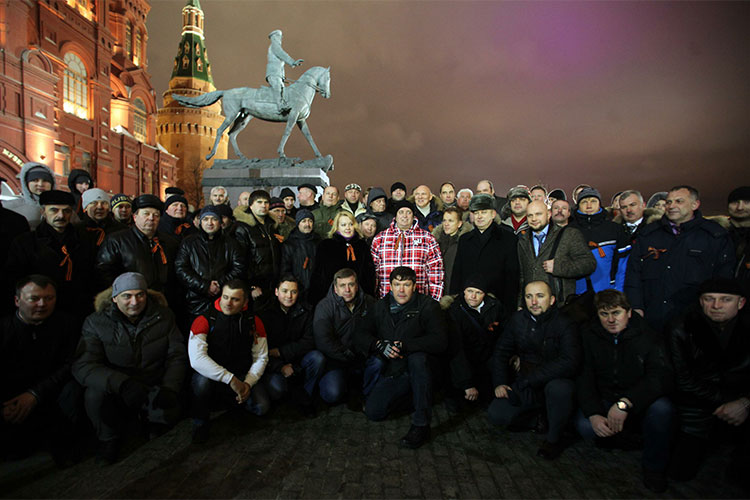In January a new pro-Kremlin movement called “Antimaidan” formed in Russia with the goal “to prevent ‘color revolutions’ in the country.” In the opinion of writer Alexander Podrabinek, the Russian government is essentially creating "death squads"—militarized civil forces to fight the opposition.

Depicted above are the activists of the new pro-Kremlin organization Antimaidan who gathered on Manezhnaya Square in Moscow in January 2015. Their next protest is scheduled for February 21, 2015—on the anniversary of the Maidan revolution. Photo: Global Look Press
On January 15, the pro-Kremlin organization Antimaidan showed itself for the first time, at a small opposition protest on Manezhnaya Square. Its members came to stand against the oppositionists. The founding members of Antimaidan include the first deputy of the chairman of the veteran’s organization Combat Brotherhood (Boevoe bratstvo) and member of United Russia Party Dmitry Sablin; president of the biking club Night Wolves (Nochnye volki) Alexander Zaldostanov (aka “Khirurg” or “The Surgeon”); co-chairman of the Great Fatherhood Party (Velikoe Otechestvo) Nikolai Starikov; member of the Council of Afghanistan War Veterans Vyacheslav Shabanov; and ultimate fighting world champion Yulia Berezikova.
It’s fitting that one of Antimaidan’s founding members gained success in ultimate fighting, as comparison can be drawn between the brute force of the sport and the Russian government’s approach to securing civil order. A strong and confident government is based on law and relies on a functioning justice and law-enforcement system to maintain order. A weak and illegitimate government relies on the constant support of its propagandists and aggressive helpers who will act without regard for the law and who are ready to fight at any time. In exchange for this loyalty, the weak government grants them immunity from criminal prosecution and their leaders are promised career opportunities and access to the regime’s honeypot.
Similar organizations have emerged in Russia before, but they were not of such an openly criminal nature as Antimaidan. Various pro-Kremlin youth movements, such as “Walking together” (Idushchie vmeste), “Ours” (Nashi), and “Locals” (Mestnye), mostly engaged in propaganda, protests, and syphoning funds given to them by the federal budget. They were pioneers, “younger brothers” of Germany’s storm troopers. Today, the time has come for more mature organizations.
“Our main goal is to overcome our opponents in number,” explained Antimaidan development strategist Yulia Berezikova in her interview to the online publication Lenta.ru. Doubtless this really is their goal: they don’t feel confident being in the minority. Their strength lies in being a crowd in which any sense of individuality is lost, giving way to uncontrollable aggression and a feeling of total impunity.
“We stand together in order to not let any ‘color revolutions,’ street riots, chaos, or anarchy occur,” states Antimaidan’s memorandum. In their numerous interviews, Antimaidan members affirm that they are prepared to use force against the opposition and that they won’t stand aside.
There are many examples in history of frightened regimes establishing militarized civil troops to fight against opposition. In the mid-twentieth century, dictatorships in Latin America created paramilitary units similar to army troops, who operated above the law as the grateful authorities protected them from prosecution. They murdered oppositionists and rich people, gaining wealth and gratifying their class hostilities by eliminating intellectuals and religious leaders. They brought death and destruction to society and as a result have been named “death squads.”
However large and forceful these government-bred criminal troops become, their fate is unenviable in most cases. When their government no longer needs them or they become too powerful, posing a threat to their masters, they are cast out on the roadside.
In the mid-1960s, Mao Zedong, the leader of communist China, who was afraid of his party’s old comrades, mobilized youth troops known as Red Guards. Their goal was "to fire at command staff"—to get rid of the old party members who might threaten the dictator’s personal power. As a result, wild crowds of students, members of the Red Guards, stormed the party’s offices and attacked anybody who had an intellectual advantage over them: teachers, professors, writers, musicians, artists.
The National Socialist German Workers’ Party (NSDAP) created storm troopers twelve years ahead of its rise to power. These troops were meant to take violent action against the NSDAP’s political opponents. They were the driving force behind the Nazis’ mutiny in Munich in 1932. They were subsequently banned, but rose to power again later. By 1933 their number totaled more than half a million members.
The latest example is Ukraine’s titushki, which were called for by former president Viktor Yanukovich to help him fight his own people, who protested for freedom and democracy on Maidan. Perhaps if Yanukovich had early on forged his titushki of ex-SWATs, policemen, professional fighters, and convicts, the group would have become more sizeable and powerful.
But however large and forceful these government-bred criminal troops become, their fate is unenviable in most cases. When their government no longer needs them or they become too powerful, posing a threat to their masters, they are cast out on the roadside. The wave of the Ukraine revolution wiped out the titushki—they disappeared right after President Yanukovich fled the country. Nazi storm troopers lost their influence a year after Hitler came to power, and their leaders, including their head, Ernst Roehm, were killed during the infamous Night of Long Knives. The death squads in South America were disarmed and dissolved before they could become uncontrollable for their creators. But even then, left without a job, they turned their weapons against their former masters, accusing them of betraying their ideals. Chinese Red Guards were forced from the streets by the army as soon as the threat to Mao Zedong’s power had disappeared. After Mao’s death, some of those responsible for China’s Cultural Revolution and the Red Guards movement were given the death penalty, sentences that were later changed to life in prison.
If Antimaidan members become active enough, they just might meet the same fate.

